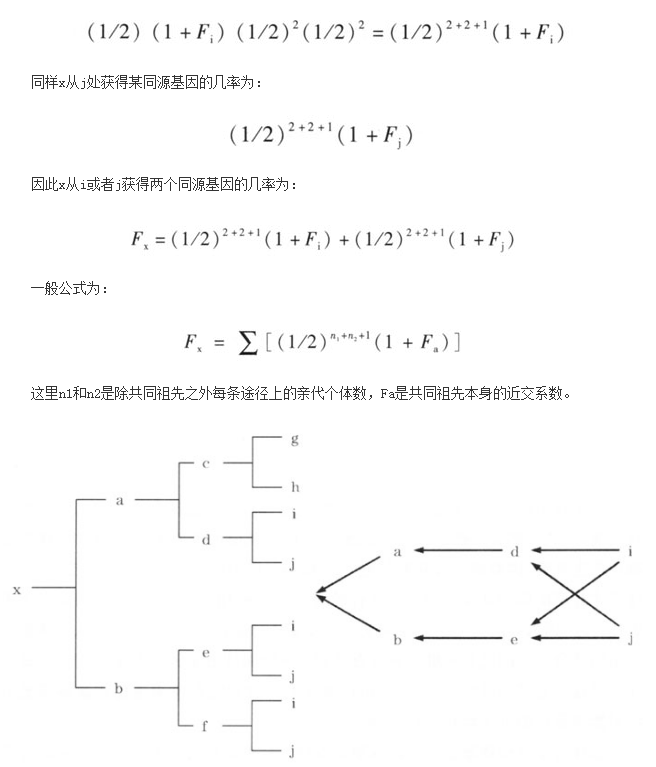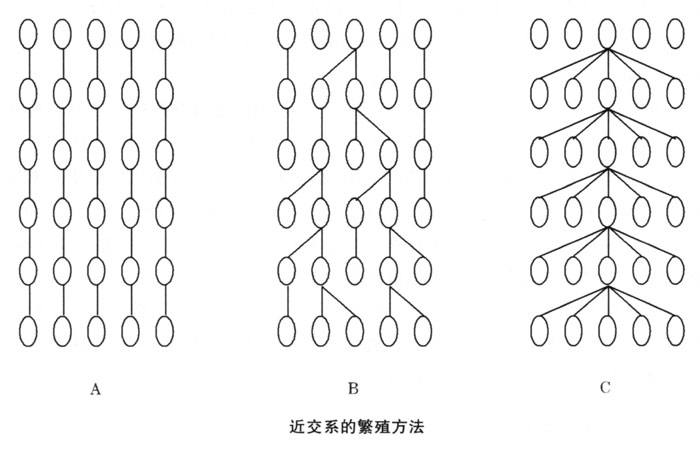
1. Basic concepts
inbreeding refers to the mating of all siblings in 20 consecutive generations. All individuals in succession can be traced back to paired common ancestors that have appeared since 20 generations. After more than 20 consecutive parents and offspring have mated with all siblings, this effect is comparable.
The selfing coefficient of inbred lines must exceed 99%.
This kind of animal does not exist in nature, it is artificially cultivated.
The above definition is very strict for the mouse. However, you may need to
is distinguished from other species of animals. In some cases, the name "inbred" simply means a decrease in genetic diversity within the strain. This situation occurs when the number of inbred generations in a line in each breeding line is less than 20. However, the allogeneic skin grafts between all individuals in the specific breeding line of this line are successful. Animals that are particularly long between two generations can use the name "inbred" as long as they are raised by several generations of compatriots. Inbred subline differentiation refers to the genetic differences that are likely to be found or exist between animals on each branch of the inbred line. Generally, sub-line distinction occurs in the following three situations:
1. The branch formed before the same level of the 40th generation (that is, the branch occurred in F20-F40).
2. A branch can be independent of other branches for more than 100 generations.
3. It is found that one branch is genetically different from another branch. The cause of this genetic difference may be residual heterozygosity, mutation or genetic contamination (that is, the mating of inbred and non-inbred animals can cause genetic changes). The subline formed by this method will need to be renamed because the subline formed by genetic contamination is usually genetically different from the original line.
2. Genetic characteristics of inbred animals
Inbred animals have homogeneity, uniform genetic composition, long-term genetic stability, personality, background information and data. (1) Gene homozygous: The loci of all animals in the inbred line must be homozygous, and the offspring of each mating of the line must also be homozygous. In other words, the genotypes are the same. The genetic characteristics are the same.
(2) Homology of genetic material: It means that all individuals of the same inbred line are genetically homologous and can be traced back to a common ancestor. Skin or tumor transplantation between individuals within the same strain will never be regarded as a foreign body, and the gene locus and locus typing are completely consistent between individuals.
(3) Phenotypic consistency: genetic and physical signs of inbred animals, including physiological, biochemical, histological, morphological characteristics (coat color, weight, etc.) and behavior types. The symptoms should be consistent and convergent. Inbred animals have the above benefits, thereby eliminating unnecessary interference with experimental results. It is usually the first choice for mammalian genetics, development, immune system, pathology, pharmacology and many other ideal materials, and has made important contributions to the research of human diseases.
Breeding, preservation and breeding process have strict requirements, but many factors that affect genetic variation can still cause genetic variation, such as genetic variation, genetic drift and genetic pollution. .. .. For newly introduced animals or newly cultivated strains, further understanding of their genetic characteristics is required. Genetic contamination between strains is a basic requirement for inbred animals and an essential element to ensure the accuracy and reliability of experimental results. Therefore, the establishment of methods to monitor genetic quality is essential to ensure the genetic quality of inbred animals.
three. Breed
In the process of breeding and protecting inbred animals, the breeding method adopted is to mate closely related individuals, such as "bringing between brothers and sisters, mother and child, father and daughter". .. The purpose of inbreeding is to increase homozygosity. As a result, the number of homozygotes increased and the number of heterozygotes decreased. The degree of inbreeding is usually expressed by "inbreeding coefficient". The coefficient of inbreeding refers to the probability that an individual in a population inherits two homologous alleles (copies of the same gene). The magnitude of the inbreeding coefficient can be calculated according to the path analysis method calculated by the system diagram.
Let us take the system diagram of Figure 1-2 as an example to see how to calculate the inbreeding coefficient of x individuals. If individual i has not previously selfed, the probability of d and e receiving homologous alleles from i is 1/2, 1/2 (1 + Fi). a. The probability of obtaining this allele from d or the allele of b from e is 1/2. The probability of obtaining this allele from a or b is also 1/2. The gene transmits d and a from i to x The probability of is (1/2)2, and the probability that e and b will be passed to x is (1/2)2. Therefore, the probability of x accepting two homologous genes from i is that of obtaining homologous genes from d Probability, e is the probability of passing d to x multiplied by the probability of passing e to x. In other words,

How to calculate the inbreeding coefficient for individuals with a short entry pedigree record above. However, in the actual reproduction process, the inbreeding coefficient often does not reach the theoretical value. This is because individuals with high fertility are often selected for breeding and reproduction, thus increasing the possibility of individuals carrying heterozygous genes. In theory, Wright calculates the inbreeding coefficient of each generation in the inbreeding process. In the first ten generations, the inbreeding coefficient of close brothers and sisters increased rapidly, and after the tenth generation, the growth rate gradually slowed down. The theoretical calculation cannot reach 100% inbreeding coefficient. The definition of "inbreeding" by the International Mouse Standardization Committee is interpreted as requiring at least 20 generations to continue mating with siblings. In this way, the coefficient of inbreeding can reach 98.6%. Therefore, on average, any individual can reach 98.6% of homozygous genes, and the remaining 1.4% of heterologous genes can be heterozygous. It shows that it has reached a high degree of genetic consistency, and has formed a "pure blood" at this moment. Therefore, the genetic effect of inbreeding is to reduce heterozygosity and increase homozygosity, so that each individual has a consistent genetic composition. Inbreeding usually involves the appearance of genetic defects. The number of premature deaths increases, and animals are generally weaker, more susceptible to disease, less productive, and more accessible to recessive genes. This phenomenon is called "weakening of inbreeding." This harmful effect is caused by many homozygous unfavorable recessive genes, such as the inability to produce enzymes required for normal life, the production of abnormal proteins and other compounds, and hormonal imbalance. As the coefficient of inbreeding increases, the degree of inbreeding decreases until the coefficient of inbreeding approaches 100%. The fecundity of inbred lines is stable, but inferior inbred lines are usually caused by environmental factors or new harmful mutations. If the birth rate increases, it may be genetic contamination. Inbreeding has many factors that affect homozygosity, including linkage, selection of active animals for mating and spontaneous mutations, which can interfere with the formation of homozygous lines. The closer the position of a gene on the homologous chromosome pair, the less the exchange. Therefore, it usually takes some time to study the appropriate exchange, and high homozygosity can be obtained. Since vigor is related to heterozygosity, choosing more active animals for mating often delays homozygosity. Natural mutations can occur at any time, thereby reducing the homozygosity of the strain. Therefore, it is necessary to continue inbreeding and monitor for new mutations. Even effective strains must be carried out with caution. This requires the use of genetic quality testing methods to regularly check the reproduction and preservation of inbred animals. The principle of choosing inbreeding methods is to maintain the homogeneity and genetic homozygosity of inbred animals. Regardless of the introduction of inbred animals or self-breeding, the following three methods are usually used for reproduction (Figure 1-3): 1. The individual plant method is shown in Figure 1-3A. Choose 3-5 species from the original inbred strains. Match your siblings and choose the most fertile pair. Then select 3-5 pairs from the offspring for reproduction. Then select the parent of the pair as the next generation. This method has good individual homogeneity, but the disadvantage is that the selection range is too narrow and it is prone to danger.
2. The parallel line method is shown in Figure 1-3B. This means you need to select 3-5 pairs of siblings from the original species to be paired, and select the next generation of breeding mice from each offspring. Go down in parallel. The advantage of this method is that it has a large selection range and helps maintain species. The disadvantage is that individuals are not uniform and easy to distinguish. In the long run, this allows animals to be divided into different subfamilies.
3. The optimization method is shown in Figure 1-3C. This method retains the advantages of the above two methods and overcomes the disadvantages of the two methods. Choose 6 pairs in each generation, and then choose each pair from the siblings of the same parents. During the reproduction process, each generation maintains 6 pairs. If a pair is not pregnant or is less productive, you can choose from another pair. Choose a good replacement from the offspring. The replacement can be paired, or you can choose one of male and female.
